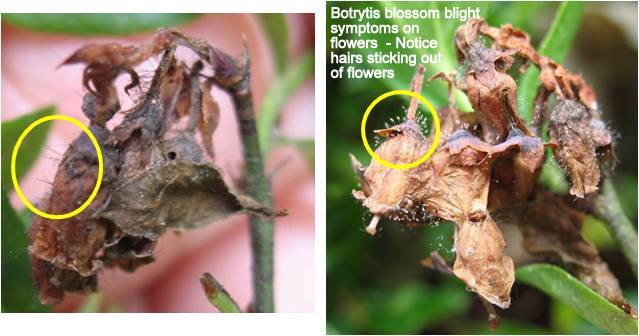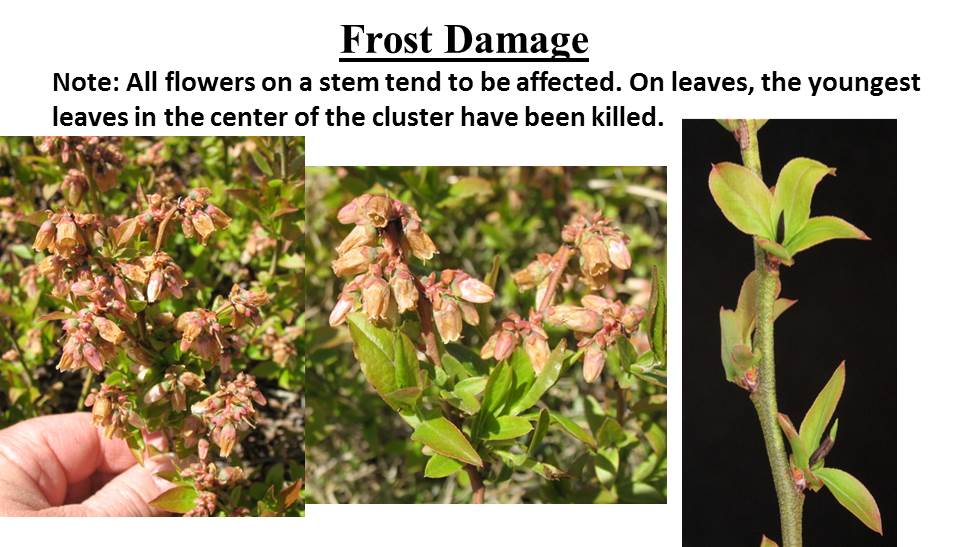5.26.14: Mummy Berry and Botrytis Blossom Blight
I think the mummy berry infection season is now over for 2014. Any remaining cups would have dried up over the last few days, so there won’t be any spores to infect the plants. I don’t think the wet weather we had this weekend or will have on Tuesday will be causing any infection periods for the mummy berry fungus.
You may be seeing symptoms of Mummy berry disease in your field now and over the next week. It is too late to spray fungicide at this time. Any symptoms you find are from infections that occurred at least nine to ten days ago. The spores produced on the dead leaves and flowers will NOT cause new killing infections. These spores will infect healthy flowers and produce mummy berries. The number of mummy berries produced is typically too low to be concerned about trying to control this stage of the disease.
Mummy Berry Symptoms
Symptoms of mummy berry disease are shown in the pictures below. This fungus does attack and kills both flowers and leaves. Flowers are typically killed before they open. The petiole (base of leaf) of leaves give a characteristic shepherd’s crook shape. Powdery gray spores can be seen at the base of the leaves or flowers where they attach to the plant. Unless it is a very susceptible clone, you will only see isolated leaves and flowers with the disease.
Frost
Frost has been minimal this year but may occur in hollows or some more sensitive clones. Frost tends to affect most of the flowers on a stem. You may also see just the green growing tip of the leaf dying off. Please see pictures below.
Botrytis Blossom Blight
You may see Botrytis blossom blight occurring in your field if you had some bloom last week. The weather over this weekend only produced conditions for Botrytis infection at our North Ellsworth and East Machias/Whiting weather station locations. Fields in this area are at risk of Botrytis infection IF the fungus is in these fields. You can scout for this disease in early blooming clones or dying tissue on weeds in the field. The symptoms are dead, open, flowers with black hairs sticking out of them (see picture below). You will probably need a magnifying glass or hand lens to see the hairs.
ONLY apply fungicides to control Botrytis blight IF
- you have seen severe infection this year in early clones, this means more than one or two blossoms affected, and
- you have had a severe problem with Botrytis blossom blight in previous years.
You will want to minimize any exposure of honey bees, bumble bees AND native pollinators to pesticides, including fungicides, during bloom. Bumble bees and native pollinators will still be working pollinating your fields when poor conditions keep the honey bees in their hives. The fungicides recommended for control of Botrytis blossom blight are considered non-toxic to honey bees BUT we do NOT know how native pollinators would react to these materials or how there may be subtle effects on honey bees and bumble bees.
My recommendation is NOT to apply fungicides to control Botrytis blossom blight unless you are SURE you have it in your field. In my experience visiting many fields reported to have Botrytis blossom blight is that the dead blossoms have been due to Mummy berry disease in the majority of fields.
If you do apply fungicides during bloom, apply them at LATE EVENING or at NIGHT to minimize the exposure of pollinators to these compounds.

Any questions please call Seanna Annis at 1.800.897.0757 (Maine only), or email at sannis@maine.edu.

